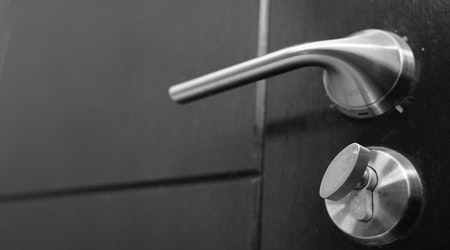Getting a Handle on Access Control
Proper installation and maintenance ensures door hardware products provide enhanced security and performance
Advances across the entire range of door-hardware products and technology have put more access control than ever in the hands of managers. From hinges and locks to handles and operators, manufacturers have introduced new products and updated existing products, all with the goal of protecting facilities and their occupants from external threats.
But the challenge for managers goes beyond properly specifying door-hardware products. Ensuring these products also are properly installed and maintained will help them perform as intended.
Specification Strategies
The type and class of door hardware are two key factors in specifying properly. Type refers to the design, and class refers to the durability.
For example, mortise locks, which have separate dead-bolts, are the type specified for exterior doors. Bored or cylinder locks, which have a combination single latch and dead-bolt, generally are specified for interior personnel doors. Each type of lock comes in several classes, depending on the expected number of cycles, or frequency of use annually.
Managers can ensure properly specified hardware by knowing the type of lock best suited to each application, as well as the frequency of use at each location.
So from an endurance standpoint, the class specified for a main entrance door would be one that could sustain much more repetitive use than the class for a mechanical equipment room requiring less repetitive use. But both would need to provide the appropriate level of security to prevent unauthorized entry, while permitting rapid egress in an emergency.
The secret to getting it right is knowing the various standards that have been developed and the products’ intended application type, as well as the standards and classes they must meet.
Door hardware standards from the American National Standards Institute/Building Hardware Manufacturers Association (ANSI/BHMA) are arranged by device type. For example, ANSI/BHMA Standard A156.13 covers mortise locks and latches, series 1000.
Recently updated standards include A156.26, Continuous Hinges, which contains added definitions for tamper resistance and plugs, along with new cycle requirements for electric hinge wire. Also, in April 2007, ANSI/BHMA revised A156.19, Power Assisted and Low-Energy Power-Operated Doors.
Software and Security
Important innovations in associated access software have enabled maintenance and engineering managers to enhance building security in many ways. For example, visitor-management software linked to access devices can provide greater control of access and safer egress. It also offers real-time counts of building occupancy with much more reliability than previous generations of products. The software enables automatic scanning identification documents, such as passports, business cards, and licenses to print bar-coded visitor badges.
The database can integrate with security alerts, sex-offender screening and alerts, and access denial. Visitors use the badges to access the building from the lobby via card-activated turnstiles, which are linked with biometric readers to ensure positive identification, and enable elevator access.
The software also can create a record log of entry and egress times for individuals. This process verifies that all occupants are out of the building in an emergency and, if not, which ones are unaccounted for.
Installation Issues
Installing door hardware is fairly straightforward, provided the installer follows manufacturer recommended procedures. Follow-up checks have shown that improper installation can inadvertently disable some security features.
For example, improper installation of fusible-link cable on sliding fire-door actuators can result in failure to close the door in a timely manner in the event of a fire. Reading the manufacturer’s installation instructions carefully takes only a small percentage of the total job time. But this important step also can save installation time, while ensuring that the job is done right and that all the features, including updates, are activated and working properly.
Manufacturers also offer emergency installation service if door hardware fails. They can provide replacement doors — with all hardware factory assembled, aligned, and tested — that are ready for quick on-site installation. They also have distributor technicians who know how to install the preassembled doors to minimize the inconvenience to occupants and shorten the time required to get the door operating.
Testing, Testing
To provide uniform products, door hardware manufacturers use ANSI/BHMA standard tests and publish the results, showing how their products compare with the standards. For example, Series 1000 mortise locks and latches must meet or exceed 1 million cycles to be labeled Grade 1, and they must meet or exceed 800,000 cycles to be labeled Grade 2 or Grade 3.
The last digit in the specific product number signifies the product’s grade. In the ongoing effort to provide high-quality products, manufacturers’ test results often substantially exceed the standard test provisions for construction, performance, endurance, and opening force. The standards test descriptions and the specification product sheets are available online and are good sources managers can review to ensure the proper fit for the application.
When inspecting and testing door hardware, technicians should compare the installed device with the standards to determine acceptability. Periodically closing fire doors by relieving the weights manually will uncover blockages that inhibit proper and complete closure.
Examples of the typical code requirements that products must meet to achieve this rating might include:
-
The device actuator — crash bar, paddle, or panel — extends at least halfway across the door.
-
The force required to open in the exit direction is at or below maximum allowed.
-
One action, such as pushing the crash bar, opens in the exit direction. If opening requires two or more actions, such as turning a thumb lock or using a key, the device does not qualify. If opening requires special knowledge of the mechanism or special devices, it also does not qualify as an emergency exit.
-
It meets fire-test requirements.
-
It meets requirements for maximum mounting height above the floor.
The location of emergency exits also should be a part of any testing procedure to make sure emergency areas can handle the emergency exits. The following are typical locations that must have emergency exit doors and appropriate door hardware:
-
every exit door from an assembly area with capacity for 100 or more occupants.
-
every door to an exit lobby from an exit stairwell.
-
every exit door from a high-hazard area.
These requirements are only examples, so managers need to check building codes.
Maintaining Hardware
Managers can’t afford to wait for complaints about door operation before scheduling maintenance of doors and hardware. By the time complaints start to roll in, major damage already might have occurred.
With door hardware, routine cleaning, checking, adjusting and lubricating go a long way. Technicians should check door alignment every one to three months, depending on the number of cycles. Some very-high-frequency applications, such as main entrances, might require more frequent checks. Maintaining good alignment helps prolong performance life by eliminating binding shock and slamming, and it ensures that secure latching occurs.
Technicians also need to inspect door checks for proper closing rate. If the rate is too high, the door will slam and result in loosening, misalignment and early failure. If it is too low, the door won’t close all the way, or wind will cause partial opening and loss of building heat and drafts.
The check has a set screw that usually requires just a fraction of a revolution clockwise to slow and counterclockwise to speed up closure rate. Hinges also should be inspected every six months. They can loosen from frequent use and might need tightening. Doing this before the door gets too far out of line can save a great deal of wear and tear on both hinges and door.
Finally, technicians should check and retighten crash-bar linkage and seats when adjusting the door alignment and check closure. Keeping the linkages tight will lead to less wear and extend life.
Roof Coatings and Title 24
California’s Title 24 underscores the merits of using white coatings on commercial and institutional buildings to reduce energy costs, according to the White Coatings Council (WCC) of the Roof Coatings Manufacturers Association (RCMA).
California Title 24 legislation requires a detailed energy audit on a new building to show that solar heat is dissipated or removed in an energy efficient manner, such as through insulation and climate control systems, unless the building uses highly reflective roofing with reflectance values above 0.70.
“California Title 24 legislation is exemplary for its support of white coatings,” says Thomas L. Meyer, the council’s co-chairman. “Exempting buildings with high-reflectance roofing from energy audits is fitting and proper because white coatings dramatically decrease the need for insulation and air conditioning.”
Alleviating solar heating loads can directly affect peak electricity requirements because peak electric loads are often the basis for the price of electricity. They establish the energy generating needs of a region.
For more information, visit www.roofcoatings.org/wcc.html.
|
Related Topics:












